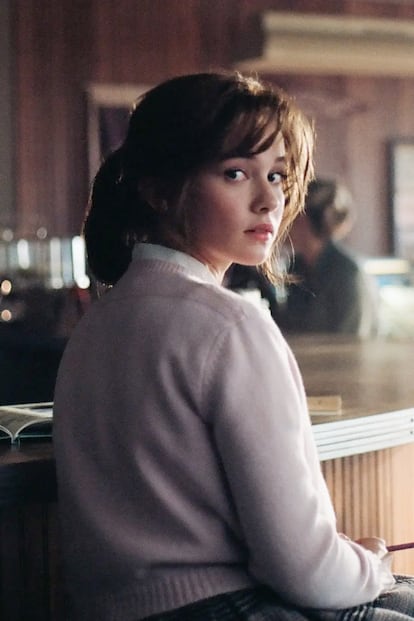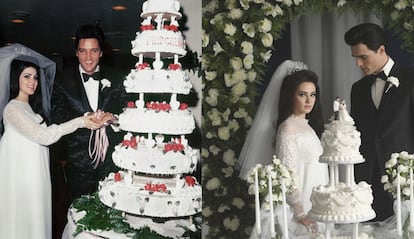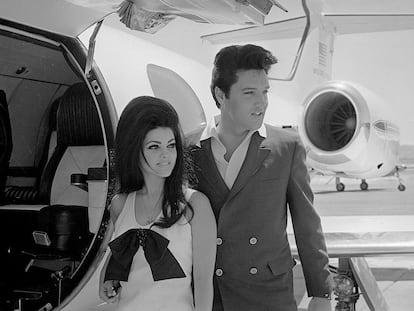‘Put on more makeup,’ ‘no brown dresses’: How Sofia Coppola told the story of Elvis and Priscilla’s toxic relationship through clothes
Stacey Battat, the film’s wardrobe designer, worked with the filmmaker on Priscilla’s looks to show the varying emotional states she experienced during the complicated life she lived with the singer

Germany, 1960. A 15-year-old Priscilla (played by Cailee Spaeny) stares into nothingness, laid out on her bed in a room that befits her age and era: floral wallpaper, cherry-colored nail polish, a glass jewelry box in the shape of a heart, pages torn from fashion magazines and a small porcelain tea set. But there’s one detail that sets the scene apart; the military jacket that Elvis Presley wore during his years of military service in West Germany, testament to the romance that Priscilla and the king of rock sparked a few months back. With this set design in the first moments of the biopic Priscilla, perhaps more in keeping as a Pinterest moodboard than a set design for a feature film, Sofia Coppola quenched her fans’ thirst. The movie tells the story of the relationship between Priscilla and Elvis Presley from their first meeting in Europe until their separation, thanks to a script based on the 1985 memoir Elvis and Me by Priscilla Beaulieu, who is also a producer of the film.

This nearly obsessive preciousness with which Coppola’s films pose for the camera, that sense that the viewer is beholding a series of still photos, has been an unmistakable (and for fans, intensely expected) trademark of Coppola since she rose to fame with The Virgin Suicides. She defined the modern-day use of the term ‘aesthetic’ that so dominates TikTok, decades before the social network even existed. And in her detailed universe, featuring a color palette faithful to William Eggleston (Coppola cites the photographer’s work as one of her most important references), sugary songs from the past (from Brenda Lee to Tommy James & The Shondells, not to mention a version of Baby I Love by The Ramones) and shots that linger on and on, costumes are just another tool Coppola uses to build her character’s emotional side. Perhaps the filmmaker is the only one capable of bringing her vibe to any historical period she feels like: witness the pearly gothic that envelops the Civil War in The Beguiled (2017), the kinderwhore candor of the dresses in The Virgin Suicides (1999), the punk twist of Marie Antoinette (2006) and the logomania of The Bling Ring (2013).
But let us return to this waiting game in Germany. Compared to the universe of pastels and frills that reign in her bedroom, Pricilla’s wardrobe, save for a heart choker that she wears throughout the film (available as official merch from the movie’s production company A24) and a Bulova watch that Elvis gifts her, is limited to boring garments in dull hues. They stand in stark contrast with the whims of fashion magazines in the consumerist America where she fantasizes about reuniting with her love. “I want to feel sad in Germany and like the sun comes out in Memphis,” were the directions that Coppola gave to Stacey Battat regarding the emotions that should be transmitted through Battat’s wardrobe design.
Guided by this premise, the designer, who has been a Coppola collaborator since Somewhere (2010), tells EL PAÍS that each piece of clothing the character wears, from her adolescence up to her last days in Graceland, plays a decisive role in the story’s framing of Priscilla. “When Priscilla was young and she’s in Germany, I wanted to dressed her with more ample skirts, flouncy crinolines that formed her childhood silhouette. The same thing happens as she gets older; I worked with the era’s styles, like straight and pencil skirts that establish her place in the story. I wanted to make sure that you could understand that change through her clothes.”
Color, says Battat, was also a crucial element in both portraying the historical moment and the evolution of the film’s protagonist. While she’s in Germany, Priscilla limits herself to wearing grays and pastel pinks, a reflection of her age and state of mind. “When we arrive in Memphis, those colors become more saturated and go from pink to coral to yellow, the contrast between how young and innocent she is at the film’s beginning with how she becomes [Elvis’s] ideal, until she finally finds herself,” Battat told the newspaper. Priscilla’s closet, then, reflects Coppola’s poetic depiction of the character’s coming of age.

For the wardrobe planning to stay loyal to each era’s style, exhaustive archival work was required. “I saw so many photos of Elvis and Priscilla, I consulted the textile library at the Met [New York City’s Metropolitan Museum of Art] to see the era’s fabrics and page through a ton of magazines,” she says. The fruits of this labor can be seen, for one, in the 1950s full-skirted, two-piece look with matching polka-dot crop top that Priscilla wears for her triumphant arrival to Las Vegas. “I saw a similar-looking model in a Vogue magazine from that era and I was surprised, it seems too daring to be from 1962. I thought it would be wonderful to use that kind of look to reflect the moment in which a young person of her age begins to try new things, like traveling to Las Vegas for the first time,” says Battat in a recent interview.
More than 120 garments and accessories inspired by the different eras that appear in the film, from the ‘50s New Look silhouette to the floaty maxi-dresses that were all the rage at the start of the ‘70s, the moment in which the couple splits, articulated Priscilla’s closet, which grows in sophistication and complexity, just like her. The majority of the clothes, explains Battat, were made to fit instead of using vintage pieces, for one simple reason: “When you are trying to be specific, it’s more efficient to create the clothes than come across them. You don’t always find what you want and from the economic point of view, it’s also more affordable.”

Although the film does feature some of the original outfits worn by Priscilla in those years — a baby pink dress that she wears to Elvis’s departure from Germany, for example — Beaulieu didn’t get too involved in the movie’s wardrobe. It was Coppola who pulled strings to land the aesthetic that accompanies each character, with such control that Battat confesses to not having read Priscilla’s biography so as not to be influenced by it. “The important thing is to develop the character visually, so I wanted to stay true to the script and not be conditioned by what the book said. My intention was always to interpret Priscilla’s wardrobe, rather than recreate it. There are big gaps in the photographic references, and this film is about her private lives, which is the undocumented part, so it was important to be able to imagine what she was like.”
Such is the case for the bedroom scenes between the two protagonists (a sweet spot for Coppola, as can be seen in the communal beds of The Virgin Suicides, Lost in Translation and The Beguiled) or the shots of the hair salon, where Battat let herself be guided by her intuition, taking certain creative liberties to achieve the right feeling for the character.

One exception is the couple’s wedding outfits, perhaps their most famous real-life look, which they wore to the ceremony that shook the world in May 1967. Battat says that she had never seen Priscilla’s original dress in person when she collaborated with Chanel to make her bridal look. They recreated the gown, inch-by-inch, from photographs. “I went through some of Virgine [Viard, current creative director at Chanel]’s oldest collections until I found the lace that I wanted the Chanel team to work with,” she says. Valentino designed the groom’s suit, which was also a replica of the original, and it came with a tag featuring Elvis’s name sewn inside the jacket alongside that of the Italian fashion house. “It was a dream working with Valentino,” says Battat.
Nonetheless, the uniform that Priscilla’s wears to Catholic school in Memphis is one of Battat’s favorites out of all the film’s outfits. “We made them based on the original from Immaculate Conception High School. I love that the color is otherworldly, but the costume itself is so ordinary, kind of like Priscilla’s experiences,” she says on her Instagram account, referring to how the character graduated, fell in love and simply grew up. Perhaps Priscilla led a glamourous life at night, with lots of polish and eyeliner, but during the day, she had to dress like everyone else. “Priscilla is a normal girl, but she lives an extraordinary life,” says Battat.
The wardrobe designer’s work reinforces the narrative thread of the toxic relationship, a dysfunction that led to Priscilla’s breakup and exit. Amid so many false lashes, nail lacquer and ‘70s shine, the New York filmmaker’s movie is a denouncement of the abuses that Priscilla says she lived during the relationship, from infidelities to physical and psychological abuse, her introduction to drugs and humiliations that took place in the privacy of their home. “Don’t wear anything brown, it reminds me of the army”, “dye your hair black and wear more makeup” and “don’t wear prints” are some of the orders that, the movie reveals, Elvis used to mold his spouse as though she were his doll. All this uncovers a side of the artist that is much darker, more toxic. Battat had all this in the forefront of her mind and played a central role in crafting the attention-grabbing transformation that Priscilla undergoes, using a vertiginous bouffant and excessive cat eye, created by British makeup artist Jo-Ann MacNeil, who is nominated for a Critic’s Choice for her work.
Aesthetic also serves as revenge when the relationship ends. That’s when Priscilla appears bare-faced, her skin finally natural, with a simple shirt and pants, having left the glamour behind. “You have everything a woman could want,” blurts out Elvis, uncomprehendingly. Everything, except the most important thing. “You’re losing me for a life of my own,” Priscilla tells him.
Sign up for our weekly newsletter to get more English-language news coverage from EL PAÍS USA Edition
Tu suscripción se está usando en otro dispositivo
¿Quieres añadir otro usuario a tu suscripción?
Si continúas leyendo en este dispositivo, no se podrá leer en el otro.
FlechaTu suscripción se está usando en otro dispositivo y solo puedes acceder a EL PAÍS desde un dispositivo a la vez.
Si quieres compartir tu cuenta, cambia tu suscripción a la modalidad Premium, así podrás añadir otro usuario. Cada uno accederá con su propia cuenta de email, lo que os permitirá personalizar vuestra experiencia en EL PAÍS.
¿Tienes una suscripción de empresa? Accede aquí para contratar más cuentas.
En el caso de no saber quién está usando tu cuenta, te recomendamos cambiar tu contraseña aquí.
Si decides continuar compartiendo tu cuenta, este mensaje se mostrará en tu dispositivo y en el de la otra persona que está usando tu cuenta de forma indefinida, afectando a tu experiencia de lectura. Puedes consultar aquí los términos y condiciones de la suscripción digital.
More information
Archived In
Últimas noticias
Most viewed
- Sinaloa Cartel war is taking its toll on Los Chapitos
- Oona Chaplin: ‘I told James Cameron that I was living in a treehouse and starting a permaculture project with a friend’
- Reinhard Genzel, Nobel laureate in physics: ‘One-minute videos will never give you the truth’
- Why the price of coffee has skyrocketed: from Brazilian plantations to specialty coffee houses
- Silver prices are going crazy: This is what’s fueling the rally











































